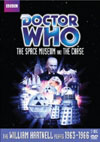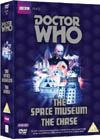DVD Extras include:
The writing isn't much on character or dialogue, but it is fast paced, whisking the audience away from each time and place before any of it becomes too boring. Episode one begins with some historical snippets, including an all-right clip of the ancient Beatles performing "Ticket to Ride". Vicki's historical point of view of them gets more appropriate with each passing year. Sadly, it seems not everyone gets to see this part of the episode, due to overcomplications with Beatles music / video rights. Apparently, PBS re-runs include this bit. Store-bought VHS video all over the world did not. Word is, DVD versions have it back in, IF you can get the European Region 2 copy, and IF you have an appropriate player and TV monitor for it. North Americans may still be expected to shell out for a copy that leaves it out - and who knows how butchered the audio commentary will be that talked over this clip as well. Episode Two's title - "The Death of Time" - seems to have nothing whatsoever to do with anything in the episode. Terry Nation was particularly nasty towards the Aridians he created - they've got lots of problems of the type that the Doctor would typically resolve in heroic fashion, and even more damning in this case, the problems arise BECAUSE of his presence, but the Aridians only get his sympathy this time around. He's too busy trying to get himself and his companions out of a predicament, and is happy to take advantage of their problems when it offers him a chance to escape. The Aridians end up much worse off after the Doctor's brief visit. In our director's defense, we have to give Richard Martin credit for giving us the FIRST example of the TARDIS dematerialization sound being REVERSED during a landing in episodes three and four. Nice one! All that remains is to lop off the final wheeze and add a thud, and you'd have the sound we all became accustomed to hearing throughout the 1970's and 1980's. The acting still remains cheesy throughout though. The tour guide's New York accent isn't bad, but somehow it's still obviously faked. The dialogue isn't very natural either - too much emphasis on sounding like a New Yorker, and not enough on saying something intelligent. Then we come to Peter Purves' debut as Morton Dill. I admire the way he can usually throw himself completely into a role with a lot of energy and make it watchable, but poor old Morton is scripted to go way over the top, so that's what you get. This is one of only three scenes to show the Dalek Time Machine coming and going properly, so enjoy it while it lasts. There are some better performances in the Marie Celeste sequence, (or Mary?), not to mention a very atmospheric sequence of the abandoned ship, but the scripted interaction between guest characters and regulars is pretty dull at this point. The same can be said of the haunted house sequences - as far as horror and suspense goes, the house and its characters are far too much of a badly-acted joke. I think it was a mistake to hide the true nature of both of these locations until after all our travellers leave the scene. The Marie Celeste sequence holds no true interest for our main characters or the audience until after we realise what ship we were on, which is too late. Sir Ian Chesterton and the Doctor come up with some fascinating theories for the haunted "dimension of fear" location, which would support the apparitions' ability to withstand Dalek fire. The fun-house revelation cheapens the whole sequence, not to mention the Daleks' abilities and sense of menace. What we get for action here is pretty cheesy anyway, more mindless mayhem and running about. Some itchy cameraman had to readjust the frame of the TARDIS inlay shot, giving away the effect once again. At least we get plenty of drama out of Vicki's makeshift travel arrangements and the Daleks' increasingly devious plans. I see an expensive cut was used to go from the Doctor's double to a close up of William Hartnell. Why not make the cut a little earlier, and let William Hartnell do the whole final scene? Then you'd never know a double was used! Although the landings on Mechanus are sub-standard, we've been seeing a lot of them lately anyway, so that's okay. Simply by exercising his sole right to pilot the TARDIS, the Doctor has generally had more important things to do than any of his companions so far in this adventure. At long last, episodes five and six give us some excellent examples of Hartnell Heroism, which season two has sorely been lacking. Although it's fairly obvious which of the two Edwardian gentlemen is William Hartnell and which is the actor's double, it isn't so obvious to tell the Doctor from the Dalek robot, as the two actors swap roles frequently. And I think we have to give thanks to both Terry Nation for asking for this sequence and Richard Martin for delivering it, because this is so much better than the TV version of "The Massacre" (story no. 22), which tried in part to base itself much more heavily on the idea of William Hartnell's double, and failed to come up with as entertaining or effective a sequence as what we get here. The companions do their best to sort things out and help, but only the Doctor can be sure who's Who, and he alone deals with the Robot in the end. There's also a nice moment when the Doctor decides to face the Daleks alone to spare his companions - a futile gesture, but bravely heroic - I'm very glad that avenue was explored before it was discarded. William Hartnell's the man in episode five. Thank you, Terry Nation, for finally figuring it all out! Episode five also has the best cliffhanger. The Mechanoids make a sudden and enigmatic entrance, while the audible Dalek threat encourages the four travellers to take their chances with the new creature. Episode Six proceeds to be the most interesting of all during "The Chase". Although the model work shows up a bit with the tiny tug-and-pull Mechanoid, the sequence remains interesting with scenes that double for exploration of the city and for first contact. A soon-to-be companion is introduced, bringing the main cast up to five, as Peter Purves switches to the role he will be most remembered for on Doctor Who. The scenes of Steven Taylor meeting the rest of the crew demonstrate that Purves is a much more sensible actor than he might have at first appeared, and Steven is quite a charming, friendly fellow. (On a PBS TV broadcast, Lionheart's episode six credits attempt to serve the entire story, and unfortunately Peter Purves is credited for Morton Dill again, with no mention of his more important role as Steven Taylor. Who does these credits? Don't they pay attention to the series?) The script has a big hole in its logic here. Steven says that the Earth's population forgot all about the half-built colony on Mechanus, yet he knows all about its history, and finds it incredible that the time travellers don't. This could easily be sorted out or explained one way or the other, but the script didn't do the job. The worst part of episode six are the Dalek portrayals in the video studio. The so-called conquerors of the universe are far too lamely put out of action in this one. A Dalek barely gets touched by the flimsiest of a Mechanoid's limbs, and he cries out "totally immobilized!" without even making an attempt to free himself. The Doctor finally uses the device he's been building for the last two episodes, and actually gets to knock out one of the Daleks, so good for him, and very heroic. Too bad the Dalek decides to ham it up and wail uncharismatically, while the tiniest puff of smoke pours out of the Doctor's machine, and after a badly timed cue, out of the Dalek. This is too lame for forgiveness. Things begin interestingly enough when the five travellers prepare to scale down from the city on a rope, and Vicki has a real challenge to overcome her fear. Sir Ian makes a real idiot out of himself at this point though. His grip on Barbara seems to be designed to let her fall over the edge minus her pants. If that isn't bad enough, he lets go of her completely, and ignores all the reassurances he had just given to Vicki, to go chase after a panicking Steven. Sure Steven should have stayed to help, but it's not your place to fix his attitude and neglect your own responsibilities, Sir Ian! What a pair of unwatchable dorks! What happened to Sir Ian's solid guts? Where is the director when you need him? The Doctor's the only man left towing the line, so let's hope his reserve alien strength comes into play. The filmed battle between the Daleks and the Mechanoids is a VAST improvement on their video interaction. It's not very good at showing exactly what is happening to which character, but in this particular case, high energy mayhem is the only thing that needs to come across to keep the story moving, and there is plenty of that. Both Daleks and Mechanoids turn out good, menacing, in-character performances here, so right on. Post climax, we get an important bit of drama, as Barbara and Sir Ian make their exits. The writing, acting and everything are generally really well done from here on. I was always particularly impressed by the creativity in the sequence of still photos of Barbara and Sir Ian back in 1960's London. I later learned that Douglas Camfield took those shots. Somehow, I'm not surprised. I'm not sure why we get a shot of Steven making it safely to the ground, but no scene of him joining the Doctor and Vicki in the TARDIS. It makes the Doctor appear needlessly callous in abandoning a fellow survivor, when indeed this was not the case.
ConclusionsAll in all, episode six is an action-packed landmark half hour, and the Doctor fares well in both the heroic and character departments. All things considered and balanced, an above average episode not to be missed. "The Chase" is definitely the best of Richard Martin's season two stories, and remains particularly gripping from the middle of episode four to the end.
International Titles:Deutsch: (Die Verfolgungsjagd)
Episode two may win a prize for having the dumbest title in all of Doctor Who history. It's morbid, while having absolutely nothing to do with the episode's content. Too bad none of the other languages chose to improve on it. Episodes 3 and 6 definitely have the best titles in this story.
This story has become available on DVD and VHS video. Click on the Amazon symbol for the location nearest you for pricing and availability:
Comments on this article are welcome. You may contact the author from this page:
|








